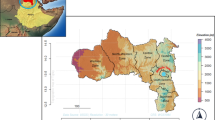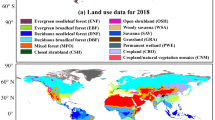Abstract
In terms of Chinese climate-vegetation model based on the classification of plant functional types, together with climatic data from 1951 to 1980 and two future climatic scenarios (SRES-A2 and SRES-B2) in China from the highest and the lowest emission scenarios of greenhouse gases, the distribution patterns of vegetation types and their changes along the Northeast China Transect (NECT) and the North-South Transect of Eastern China (NSTEC) were simulated in order to understand the driving mechanisms of vegetation changes under climatic change. The results indicated that the vegetation distribution patterns would change significantly under future climate, and the major factors driving the vegetation changes were water and heat. However, the responses of various vegetation types to the changes in water and heat factors were obviously different. The vegetation changes were more sensitive to heat factors than to water factors. Thus, in the future climate warming will significantly affect vegetation distribution patterns.
Similar content being viewed by others
References
Leeman R. The use of plant functional type classifications to model global land cover and simulate the interactions between the terrestrial biosphere and atmosphere. In: Smith T M, Shugart H H, Woodward F I, eds. Plant Functional Types—Their Relevance to Ecosystem Properties and Global Change. Cambridge: Cambridge University Press, 1997. 289–316
Zhou G X, Wang Y H, Jiang Y L. Global change and water-driven IGBP-NECT, northeast China. Earth Sci Front (in Chinese), 2002, 9(1): 198–215
Koch G W, Scholes R J, Steffen W L, et al. The IGBP Terrestrial Transects: Science Plan. International Biosphere-Geosphere Programmme (IGBP). 1995
Box E O. Plant Functional Types and climate and the global scale. J Veg Sci, 1996, 7: 309–320
Steffen W L, Scholes R J, Valentin C, et al. The IGBP terrestrial transects. In: Walker B H, Steffen W L, Canadell J, et al, eds. The Terrestrial biosphere and Global Change: Implications for Natural and Managed Ecosystems. Cambridge: Cambridge University Press, 1999. 66–87
Canadell J G, Steffen W L, White P S. IGBP/GCTE terrestrial transects: dynamics of terrestrial ecosystems under environmental change. J Veg Sci, 2002, 13: 298–300
Koch G W, Scholes R J, Steffen W L, et al. The IGBP Terrestrial Transects: Science Plan. IGBP Report. 1995
Zhang X S, Gao Q, Yang D A, et al. A gradient analysis and prediction on the Northeast China Transect (NECT) for global change study. Act Bot Sin, 1997, 39: 785–799
Peng S L, Ren H. The North-South Transect of Eastern China (NSTEC) for global changes studies. GCTE News, 2000, 16: 6
Wang Y H, Zhou G S. Primary study on characteristics of Leymus chinensis in two soil types. Acta Agrest Sin (in Chinese), 2000, 8(3): 267–272
Wang Y H, Zhou G X. Analysis and quantitative simulation of stomatal conductance of Aneurolepidium chinense. Acta Phtoecol Sin (in Chinese), 24(6): 739–743
Wang Y H, Zhou G X. Analysis on ecophysiological characteristics of leaf photosynthesis of Aneurolepidium chinense in Songnen grassland. Chin J Appl Ecol (in Chinese), 12(1): 75–79
Tang H P. Distribution of C4 plants along the Northeast China Transect and its correlation to the environmental factors. Chin Sci Bull, 1999, 44(14): 1316–1320
Tang H P, Zhang X S. A new approach to distinguishing photosynthetic types of plants: a case study in Northeast China Transect (NECT) platform. Photosynthetica, 1999, 37: 97–106
Jiang G M, Tang H P, Yu M, et al. Response of photosynthesis of different plant functional types to environmental changes along Northeast China Transect. Trees, 1999, 14: 72–82
Wang R Z. Photosynthetic pathways and life forms in different grassland types from North China. Photosynthetica, 2002, 40: 243–250
Yue T X, Zhou C H, Li Z Q. et al. A theoretical analysis on models for biological diversity. Geo-information Science (in Chinese), 1999, 1: 19–25
Li Z Q. The Complexity and diversity of typical plant communities along the Northeast China Transect (NECT). Acta Bot Sin, 9: 971–978
Ni J, Zhang X S. Climate variability, ecological gradient and the Northeast China Transect (NSTEC). J Arid Environ, 2000, 46: 313–325
Ni J. A biome classification of China based on plant functional types and the BIOME3 model. Folica Geobot, 2001, 36: 113–129
Ni J. Plant functional types and climate along a precipitation gradient in temperate grasslands, Northeast China and Southeast Mongolia. J Arid Environ, 2003, 53: 501–516
Wang R Z, Gao Q. Climate-driven changes in shoot density and shoot biomass in Leymus chinensis (Poaceae) on the North-east China Transect (NSTEC). Glob Eco Biogeogr, 2003, 12: 249–259
Wang R Z, Gao Q, Chen Q S. Effects of climatic change on biomass allocation in Leymus chinensis (Poaceae) along the Northeast China Transect (NECT). J Arid Environ, 2003, 54: 653–665
Peng S L, Zhao P, Ren H. The possible heat-driven pattern variation of zonal vegetation and agricultural ecosystems along the North-South Transect of China under the global change. Earth Sci Front (in Chinese), 2002, 9(1): 217–226
Gao Q, Li X B, Yang X S. Responses of vegetation and primary production in north-south transect of eastern China to global change under land use constraint. Act Bot Sin, 2003, 45(11): 1274–1284
Zhang X S, Gao Q, Yang D A, et al. A gradient analysis and prediction on the Northeast China Transect (NECT) for global change study. Acta Bot Sin (in Chinese), 1997, 39(9): 785–799
Wu C Y. China Vegetation (in Chinese). Beijing: Science Press, 1980
Weng E S, Zhou G S. Defining plant functional types in China for global change studies. Acta Phytoecol Sin (in Chinese), 2005, 29(1): 81–97
Weng E S, Zhou G S. Modeling distribution changes of vegetation in China under climate change. Environ Model Assess, 2006, 11(1): 45–58
Hou X Y. Vegetation Map of People’s Republic of China (in Chinese). Beijing: Map Press, 1982
Gao X J, Ding Y H, Zhao Z C, et al. Climate change due to greenhouse effects in China as simulated by a regional climate model Part I: evaluation of the model simulations. Acta Meteorol Sin (in Chinese), 2003, 61: 20–28
Gao X J, Ding Y H, Zhao Z C, et al. Climate change due to greenhouse effects in China as simulated by a regional climate model Part II, climate change. Acta Meteorol Sin (in Chinese), 2003. 61: 29–38
Institute of Soil, Chinese Academy of Sciences. Soils of China (in Chinese). Beijing: Science Press, 1978
Woodward F I. Climate and Plant Distribution. Cambridge: Cambridge University Press, 1987
Woodward F I, McKee I F. Vegetation and climate. Environ Int, 1991, 17: 535–546
Yates D N, Kittel T G F, Cannon R F. Comparing the correlative Holdridge models to mechanistic biogeographical models for assessing vegetation distribution response to climatic change. Clim Change, 2000, 44: 59–87
Prentice I C, Cramer W, Harrison S P, et al. A global biome model based on plant physiology and dominance, soil properties and climate. J Biogeogr, 1992, 19: 117–134
Author information
Authors and Affiliations
Corresponding author
Additional information
Supported by the Knowledge Innovative Project of the Chinese Academy of Sciences (Grant No.KZCX2-SW-133) and National Key Basic Research Specific Foundation (Grant No. 2006CB400502)
Rights and permissions
About this article
Cite this article
Zhang, Y., Zhou, G. Terrestrial transect study on driving mechanism of vegetation changes. Sci. China Ser. D-Earth Sci. 51, 984–991 (2008). https://doi.org/10.1007/s11430-008-0065-9
Received:
Accepted:
Published:
Issue Date:
DOI: https://doi.org/10.1007/s11430-008-0065-9




